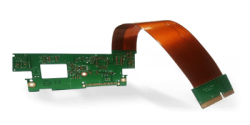Flex/Rigid-Flex
Design is about options and you may be required to place multitudes of functions in a smaller space. This enhances the latest technology usage and while optimizing real estate.
Items to consider: COST, SIGNAL INTEGRITY, CONFIGURATION

Advantages
Using flexible circuit boards over the usual rigid types
Reliability and Durability – Flex circuits can absorb and reduce effects of shock and vibration to itself and related solder joint connections.
Heat Dissipation – Flex circuits can dissipate heat at much better rates than do other dielectric materials typically used for rigid PCBs, while still offering the benefits of flexibility.Materials used for flexible circuits show exceptional thermal stability.
Economical – Designers can reduce the packaging and material costs of the finished assembly, because the thin and flexible polyimide film requires a far smaller area.
Flexibility – The elastic nature of flex circuits allows them to be packaged, folded, and positioned around folds and edges. This is especially helpful in electronic devices that require connections in all the three axes.
Weight and Space Savings – Typically, flex circuit boards take up only 10% of the weight and space of wires within a device. Flex circuits also can decrease the dimensions and weight of devices by up to 60%.
Bending Cycles – Flexible circuit boards are made with polyimide as the standard base material, capable of as many as 200,000 bending cycles.
Free Flex Consultation
Flex designs can be complex.
Get a free consultation with one of our experienced design engineers.
Types of Flex Circuit Boards
Single-Sided PBC
Single-sided PCB or single-layer flexible circuits are the most basic type of flexible circuits. They consist of a flexible dielectric film laminated to a single sheet of copper. The copper layer is then chemically etched according to the specified circuit pattern design. Polyimide coverlays can be added to the circuit board for additional insulation and protection, if desired.
Single-Sided features include:
- Very thin construction
- 1 conductor layer
- Supported and unsupported finger areas
Single-Sided Flex can be used in:
- Dynamic flexing applications
- Unusual folding and forming applications
- Installation / service applications / repair
- Limitations on space / thickness
- Installation / service flexing
Double-sided PCB
Double-sided PCB have two conductive layers – one on each side of the base layer. The two conductive layers have an insulating layer between. Trace patterns can be created on both sided of the substrate film and can be connected withe copper plated through-holes (PTH). The plated through holes make electrical connections between the two layers.
Double-Sided features include:
- Component assembly is available on both sides
- 2 conductor layers
- Fingers are an integral part of the conductor
Double-Sided Flex can be used in:
- Ground and power plan applications
- Dense surface mount assembly
- Shielding applications
- LCD module for mobile phones
- Digital cameras
- Optical pick-up for AV and computers
